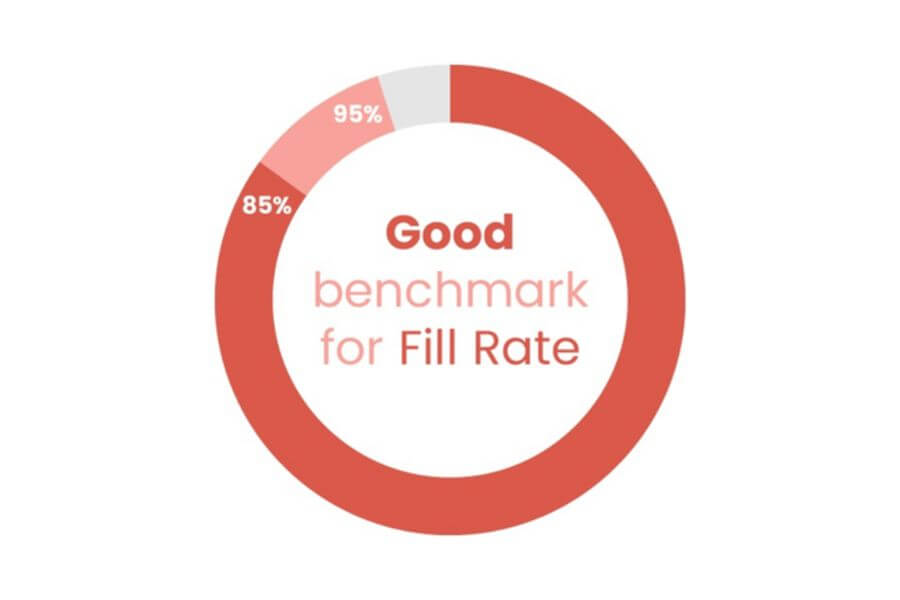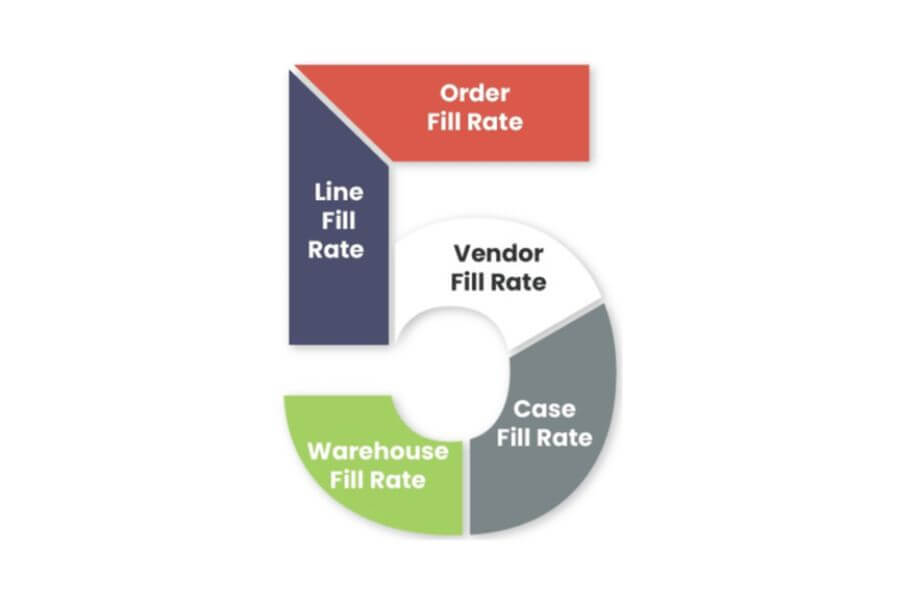Fill rate, in the context of supply chain and inventory management, refers to the percentage of customer demand that a business successfully fulfills from its available stock. Imagine a customer places an order on your online store. The fill rate shows the percentage of that order you can ship immediately. If you can send the whole order, your fill rate is 100%. If you can only send part of it due to low stock, your fill rate drops.
This number is vital for businesses. It shows how well your system meets customer expectations by delivering products on time. Intrigued? Stick with us as we explore why this number is crucial for businesses aiming not just to survive but to thrive in today’s competitive markets!
What is Fill Rate?
Fill rate is a statistic that is used in the logistics and supply chain industry to measure how many completed and on-time orders a company has fulfilled. It is used to understand the reliability and efficiency of your supply chain, and how well you can meet customer demands. As such, it is also considered an important metric for customer satisfaction. A high fill rate then means that your company has streamlined processes, rigid inventory management, and satisfaction among customers.
Fill rate has become more important than ever in an economy where 42% of shoppers naturally ‘expect’ a shipping option that delivers in under two days. Stock mismanagement and slower delivery routes are no longer an option when the market has extremely competitive fill rates.
How is Fill Rate Calculated?
The fill rate is calculated by dividing on-time orders that have no recorded complaints as a percentage of the total number of orders that a company has fulfilled. According to the Institute of Supply Management, a good benchmark for fill rate is 85% to 95%. A general rule of thumb is to have your percentage around the ballpark of 90%, which would mean your company is reliably fulfilling orders.
This metric varies depending on which niche and industry you operate within, but do note that a 100% fill rate is not advisable as it indicates that your company has an excess of stock and is spending more of its cash flow than it needs on inventory upkeep. While you want to avoid backorders and stockouts, excess inventory is just as much of a problem, making the fill rate a fine line to balance.

Service Level vs. Fill Rate
Fill rate is also often confused with service level, which are similar metrics that focus on different aspects of the same business. While the fill rate identifies how many orders you can fulfill without complaints and issues, the service level is a measure of the chances a product is available when an order for it needs to be fulfilled. The latter is more focused on the efficiency of a company’s processes, while the former relates to your ability to fulfill customer demand.
Another important metric here is the reorder point, which is dependent on both the fill rate and service level. The reorder point is an optimal level in inventory management at which the company replenishes the stock of a product before it fully runs out of it. A higher service level usually means a higher reorder point.
Five Different Types of Fill Rates

1. Order Fill Rate
As we explained earlier, this measures the percentage of orders that a company fulfills without any recorded complaints or issues. This is the most direct indicator of customer loyalty and satisfaction, as it simply means your customers are getting their orders on time. These will be the same customers that will market your products for you through word of mouth, and keep coming back to you for more purchases in the long run. Order fill rate is also the easiest way to identify bigger bottlenecks within your supply chain and order fulfillment processes.
2. Line Fill Rate
This is a more precise metric as it looks at product categories and the percentages of orders fulfilled within each product line rather than a larger company level. Perhaps one of your product categories is very efficiently fulfilled and another is bottlenecked by inventory mismanagement. In such a scenario, using line fill rate is the best way to analyze which of your product lines you need to allocate more of your valuable resources to. This gives you a more holistic picture of your order-fulfillment processes, rather than a company-wide metric.
3. Vendor Fill Rate
Vendor fill rate is more relevant if you have a large network of suppliers, distributors, and wholesalers who are operating your product. It is a percentile calculation of how many of your vendors fulfill their orders without registered complaints. This helps you identify vendors who act as bottlenecks in your supply chain, stopping you from fully being able to deliver on your customer’s demands.
4. Warehouse Fill Rate
Similar to vendor fill rates, warehouse fill rates allow you to analyze how many orders is each warehouse able to fulfill without complaints and issues. If your company is particularly struggling with inventory management, this metric can help you weed out warehouses that are underperforming and can have more resources allocated to avoid inventory mismanagement.
5. Case Fill Rate
This also pertains to wholesalers and distributors, but instead of calculating the percentage based on fulfilled orders, it calculates the percentage on the basis of the number of product cases shipped.
Why is Fill Rate Important in Logistics?
Punctuality often makes or breaks a deal in the business world, and late deliveries can send ripples through a company’s reputation, ultimately impacting the bottom line. This is where fill rates come in, making sure that your organization remains safe from the negative effects of late deliveries. Let’s find out more about why it’s so important.
Higher Sales Revenue
Once your company builds a reputation for delivering timely orders, customers are more likely to come back to you whenever they need the same product. Repeat orders do not just create recurring customers, but loyal ones.
Better Supplier Relationships
Knowing your fill rate helps you negotiate with suppliers in an objective way to measure their performance. This improves collaboration in the long run, making sure products are available when needed, and deliveries are on time. It is also an easy metric to regularly monitor and communicate with your suppliers through terms that are understood across the industry.
Market Advantage
If you are competing in a marketplace or niche where order fulfillment is lackluster, you can gain an immense competitive advantage by having a higher fill rate than your competitors. Customers will always prefer companies that deliver what they need faster, more reliably, and on time.
Better Operational Efficiency
Finding each of your bottlenecks from vendors to warehouses and product categories helps you guarantee better coordination between different departments of your organization and supply chain. This can include procurement, warehouse management, and most importantly, your overall customer service department.
Improve your Fill Rate with Simple Global
The easiest way to improve your fill rate is to partner with an established logistics partner like Simple Global for your order fulfillment needs. This lets you off-hand your e-commerce fulfillment needs to experts who have been operating in the industry for years. Simple Global’s services are fully integrated, taking care of everything from your inventory management to your customer services. We automate the process through which orders are sent to the fulfillment queue, reducing the need for the errors that come with the domain of manual data entry.
Simple Global’s process is entirely transparent, letting you monitor essential metrics like fill rate at your fingertips. These services do not just apply on the local level, as we operate on a global level to provide international order fulfillment to the USA and any region you want to expand your services to. All logistics decisions made by Simple Global are data-centric, looking at historical sales and fulfillment data to always provide the best vendors, warehouses, and fulfillment processes.
Conclusion
In a market landscape where customer demands are at a constant high, your business needs to have a competitive fill rate if it wants to surpass other vendors. The significance of fill rate becomes crystal clear when we consider its impact on customer satisfaction, supplier relationships, and ultimately, a company’s bottom line. Timely deliveries, made possible by a high fill rate, are the building blocks of trust and loyalty for businesses.
In the grand scheme of logistics, understanding and optimizing fill rate isn’t just a strategy; it’s a necessity for businesses aiming not just to survive but to thrive in the competitive world of logistics. Take the next step for your order fulfillment needs and maintain a 90%+ fill rate with Simple Global, your next e-commerce fulfillment partner. Request a free quote today.





